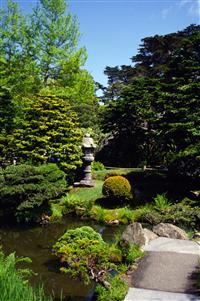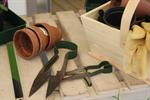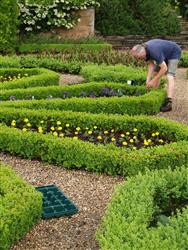Learn about Growing Plants, Horticulture and Gardening
 Horticulture is a massive employer in most countries around the world: giving us much of the food we eat, the parks, gardens and sports grounds we play in and much more.
Horticulture is a massive employer in most countries around the world: giving us much of the food we eat, the parks, gardens and sports grounds we play in and much more.
With many thousands of successful graduates, this course has been the starting point that underpins businesses and careers for countless numbers of people across every corner of the world.
If you want to start a business; increase your job opportunities or take a career to the next level; this course does precisely that for anyone who has not formally studied horticulture before.
Comment from a student: " I really appreciate Gavin's (tutor) comments and look forward to receiving the feedback from him." - Nadine
COURSE STRUCTURE AND CONTENT
There are 13 lessons in this course:
- Plant Identification
- Naming plants
- Distinguishing the taxonomic divisions of plants including family, genus, species and variety or hybrid
- Monocotyledons and Dicotyledons
- Characteristics of Botanical Families
- Structure and Arrangement of leaves and leaflets
- Leaf terminology
- Leaf Arrangements
- Flower Structure and identifying the different parts of a flower
- How seeds form
- Plant Reviews
- Collecting and Pressing Plants for Herbaria
- Planting
- Garden terminology
- Common garden problems
- Basic Planting Procedure
- Fertilising and Staking when planting
- Dealing with BaZre Rooted Plants
- Time of Planting
- Deciding where to plant
- Mulching
- Making Garden Beds
- Raised Beds
- Sunken Beds
- Planting Terminology
- Recognising Plant Families and Identifying Plants
- Becoming familiar with plant families
- Botanical Latin
- Systematic Examination of Plants -dicot or monocot, type of wood, etc
- Characteristics of important families including: Amaryllidaceae, Araceae, Asteraceae, Ericaceae, Lamiaceae, Fabaceae.
- Getting to Know More Common Families
- Other Ways to Identify Plants
- Plants for Shade
- Plants for Exposed Conditions
- Plants for Inner City Gardens
- Soils
- Purpose of Soil
- Soil Structure: Classifying soils
- Soil water and air
- Soil temperature
- Soil pH
- Nutrient Availability
- Naming a Soil
- Improving Soils
- Composting
- Natural Plant Foods
- Sampling and testing soils
- Potting soil mixes
- Soil Terminology
- Plant Nutrition
- The Nutrient Elements
- Major Elements
- Minor Elements
- Diagnosis of Nutrient Problems
- Fertilizers: nitrogen, phosphorus, potassium
- How much fertilizer to apply
- Terminology
- Water Management
- Introduction to Irrigation
- Feasibility of Irrigation
- Soil and Water
- When to Irrigate
- Water Deficiency Symptoms
- Types of Soil Moisture; gravitational, capillary, hygroscopic
- Measuring Water Available to Plants
- Rooting depths of plants
- Estimating Water Requirements
- Pumps, Sprinklers and other equipment
- Understanding Hydraulics
- Conventional Sprinkler Systems; portable, permanent, semi permanent
- Cyclic Watering
- Pulse Watering
- Irrigation scheduling
- Sprinkler spacing
- Improving Soils for Water Management
- Drainage
- Erosion Management
- Soil compaction
- Acidification
- Garden Maintenance and Weeds
- Cost of Garden Maintenance
- Machinery
- Comparing more and less costly areas of the garden.
- Common Weeds and their Identification
- Weed Control Methods -Chemical and non chemical
- Plants that become Invasive
- Environmental Weeds
- Pests and Diseases
- Pest and Disease overview
- Preventative measures for managing pest and disease
- Review of major pest problems and control options: Aphis, Borers, Caterpillar, Leaf Miner, Mealy Bug, Red Spider, Scale, etc
- Review of major Diseases and their control: Anthracnose, Black Leg, Rots, Botrytis, Damping off, Die back, Mildew, Rust etc.
- Diagnosis of Problems
- Introduction to Plant Pathology and Entomology
- Chemical pesticides and basic toxicology
- Integrated Pest Management
- Pruning
- Reasons for Pruning
- Identifying bud types
- Basic rules of pruning
- Pruning in a home orchard
- Terminology
- Winter Pruning
- Pruning tools
- Examples of Winter Pruning; Crepe Myrtle, Hydrangea, Raspberry, Fuchsia, Kiwi Fruit, Grevillea, etc
- Rose Pruning
- Landscaping
- Introduction and Pre Planning Information
- Plant Selection Criteria
- Covering the Ground
- Living Plant Cover
- Mulches
- Container Growing Outside
- General Considerations
- Terminology
- Propagation
- Methods of Propagation: Seed Propagation and Vegetative Propagation
- Propagation Structures: Cold Frames
- Cutting Propagation
- Factors affecting rooting of cuttings
- Lawns
- Turf grass varieties
- Review of common turf species
- Laying a new lawn
- Common turf problems
- Cultural techniques including watering, fertilizing, topdressing, aerating, pest and disease control
- Arboriculture
- What is Arboriculture
- How to keep trees healthy
- Where and how to cut trees to remove branches or prune
- Why remove a tree
- Ways to fell a tree
- Removing a stump
- Tree surgery; terms and techniques
Each lesson culminates in an assignment which is submitted to the school, marked by the school's tutors and returned to you with any relevant suggestions, comments, and if necessary, extra reading.
AIMS
- Distinguish between different plants, to enable identification of the plant species.
- Explain appropriate procedures for establishing a range
 of plants in different conditions.
of plants in different conditions.
- Describe the characteristics of plant growing media necessary for healthy plant growth.
- Explain the characteristics of plant nutrition necessary for healthy plant growth.
- Determine appropriate water management procedures for healthy plant growth.
- Understand appropriate procedures for pruning plants on a horticultural site.
- Determine solutions for the management of a range of common weeds.
- Determine solutions for the management of a range of common pests and diseases.
- Prepare a concept plan for the development of a garden.
- Understand commonly used plant propagation techniques.
- Develop guidelines for general lawn care.
- Develop guidelines for general tree care in a horticultural situation.
WHAT YOU WILL DO
- Distinguish between plants in order to identify at least 120 plants on plant review sheets.
- Plant out a container plant following a recommended procedure.
- Sample and carry out simple tests on different soils.
- Identify a range of nutrient problems in plants.
- Identify a range of pest and disease problems in plants.
- Demonstrate the correct procedure for pruning a plant.
- Identify a range of different plants, based on their flower and leaf structures.
- Determine appropriate procedures for planting according to type of plant and site.
- Demonstrate knowledge of how to care for plants in the garden.
-
 Demonstrate knowledge of appropriate plant selection for a range of different sites.
Demonstrate knowledge of appropriate plant selection for a range of different sites.
- Identify a range of plant health problems and describe appropriate chemical and non-chemical control methods to control those problems.
- Identify characteristics of plant growing media necessary for healthy plant growth.
- Explain the importance of organic matter in soil management.
- Describe the principles and techniques of composting.
- Determine nutrient problems and describe chemical and non-methods for overcoming these problems.
- Identify management solutions to a range of plant problems including weeds, pests and diseases.
- Explain the principles of Integrated Pest Management.
- Determine appropriate water management practices applicable to plant growth.
- Describe the characteristics of irrigation and drainage systems.
- Describe the importance of pruning to plant growth, flowering and fruiting.
- Describe safe use of chemicals.
- Develop criteria for selecting suitable plants for a landscape project.
- Prepare concept plans for landscape redevelopment.
- Draw a concept plan for a garden redevelopment.
- Demonstrate the correct procedure for taking cuttings from a range of plants.
- Distinguish between different pre-germination seed requirements and techniques, for different plant species.
- Determine appropriate turf species for different purposes and chosen climatic conditions.
- Explain the composition of lawn seed mixes and fertilizers.
- Observe and report on lawn management techniques.
- Determine solutions to lawn problems.
- Explain the cause and effect of common tree problems.
- Determine appropriate methods for treating tree problems.
Where Can this Course Lead?
Thousands of people have studied this course. Many now run their own successful garden, landscaping or nursery businesses or farms. Others work on golf courses, for parks departments, on orchards, vineyards, or for garden supply or service companies. Some have gone on to be successful in the media, and others have used this course to lay a foundation for further studies.
WHAT NEXT?
Register to Study - Go to “It’s Easy to Enrol” box at the top of the page and you can enrol now.
or
Get Advice – Email us at info@acsedu.co.uk OR
Use our FREE COUNSELLING SERVICE to contact a tutor
CLICK TO CONTACT US